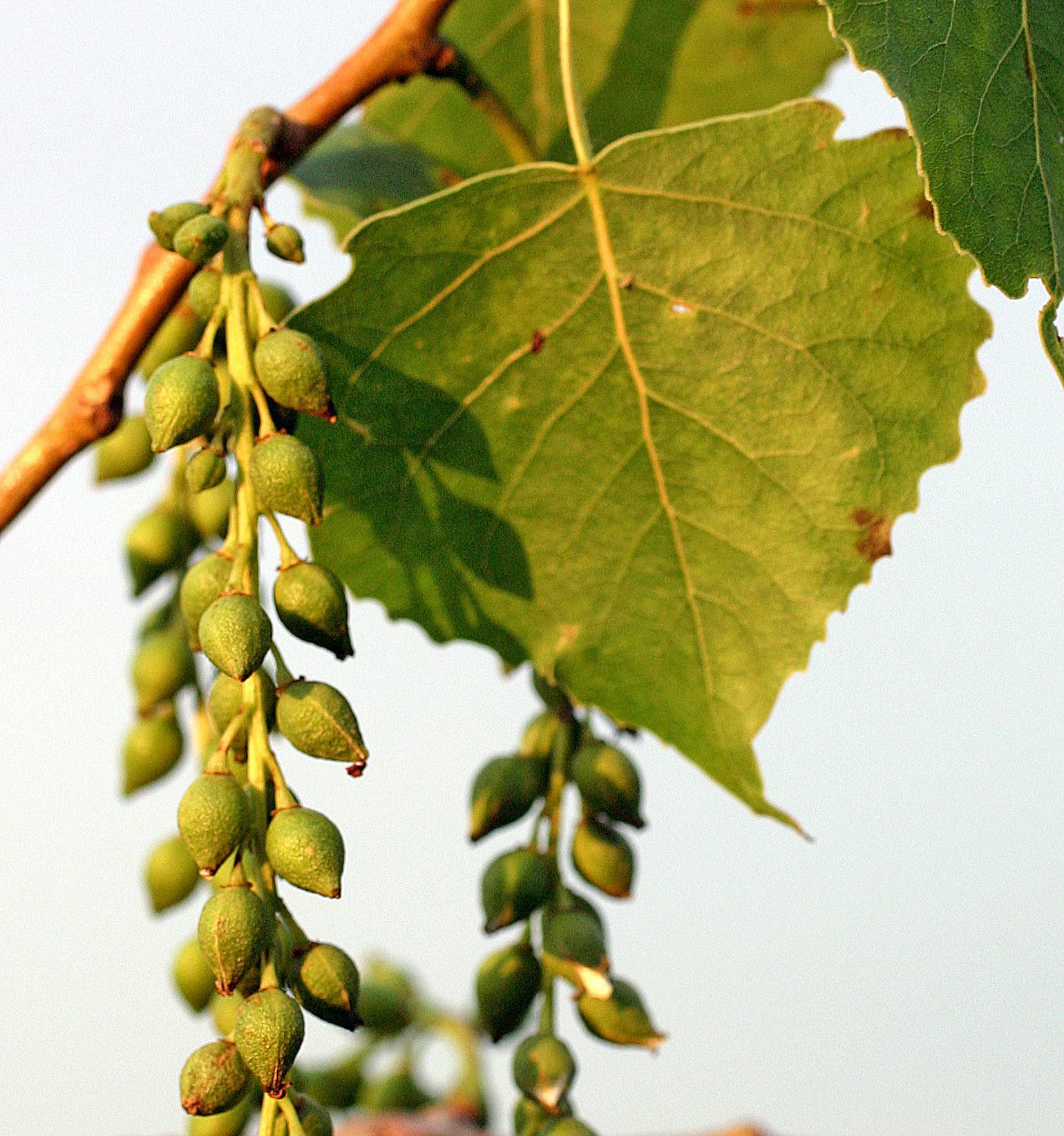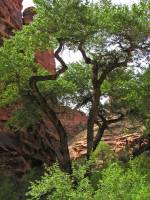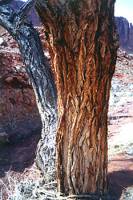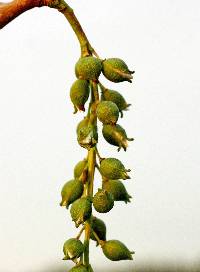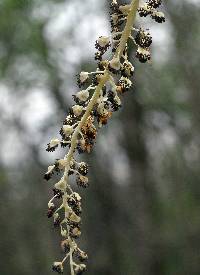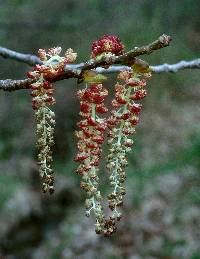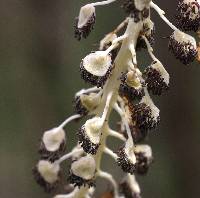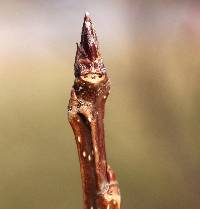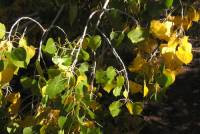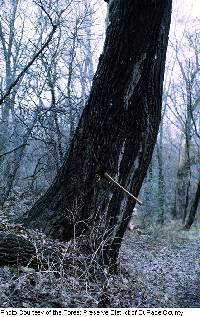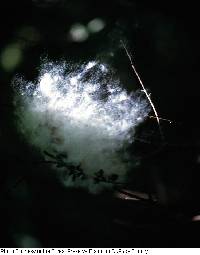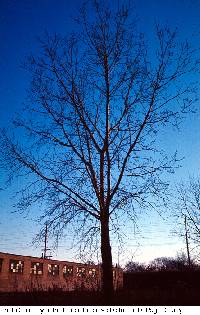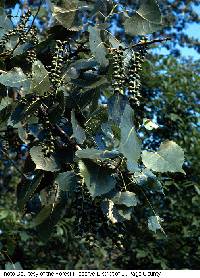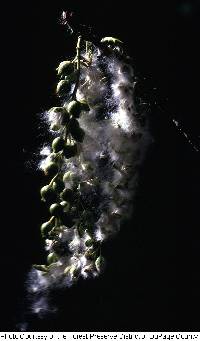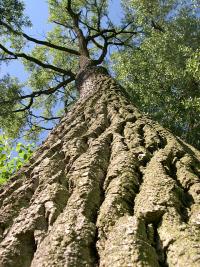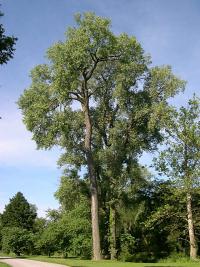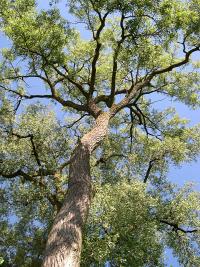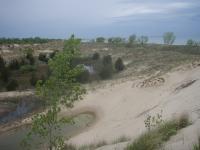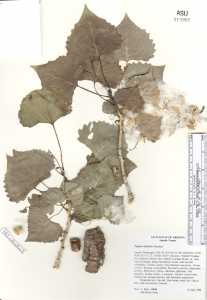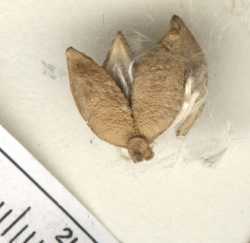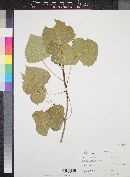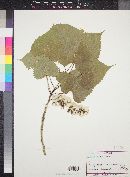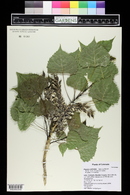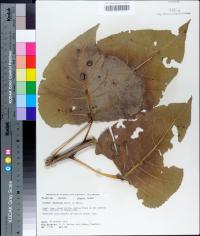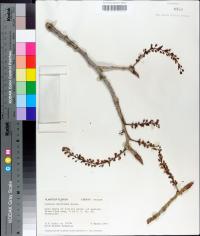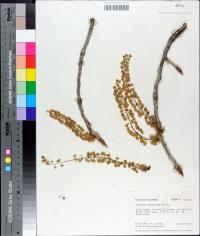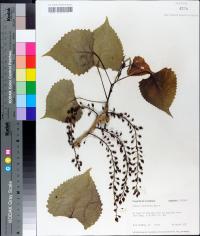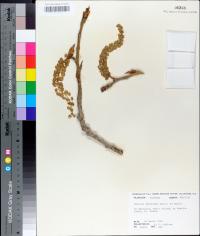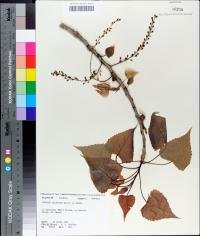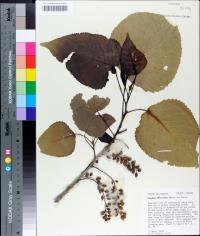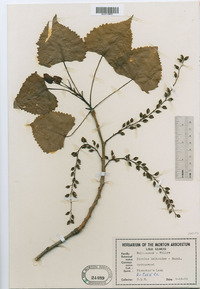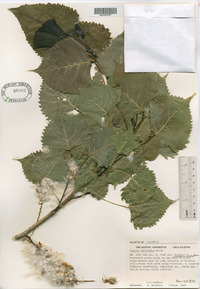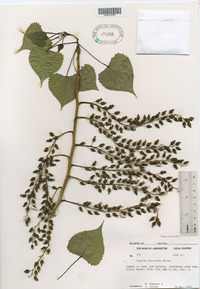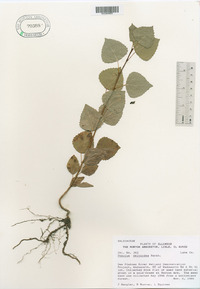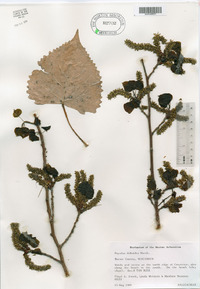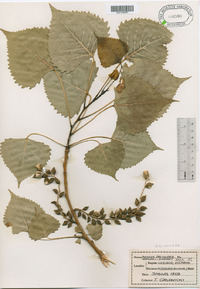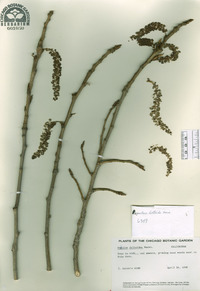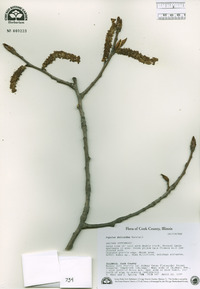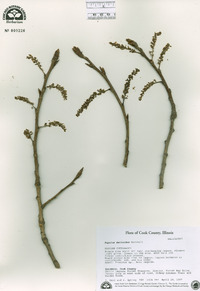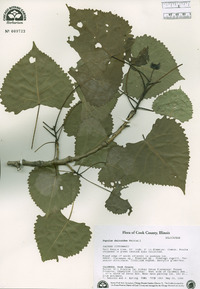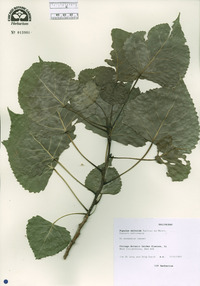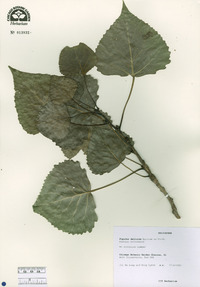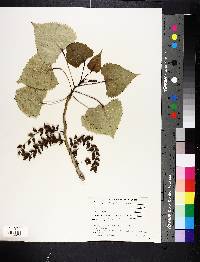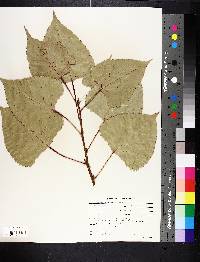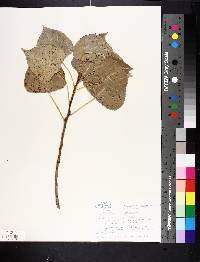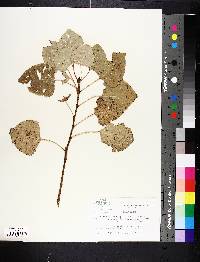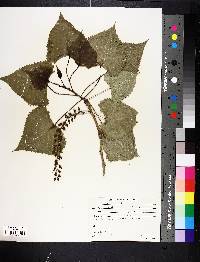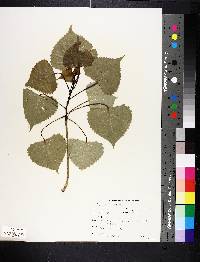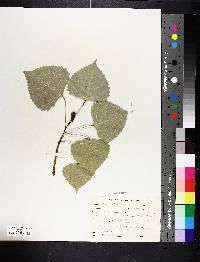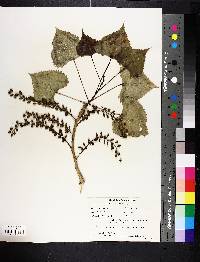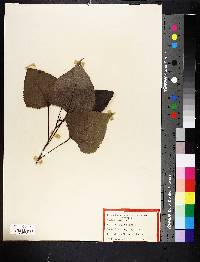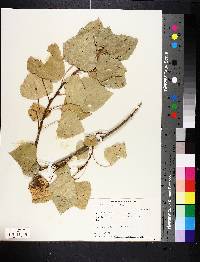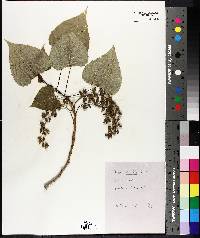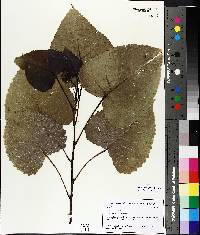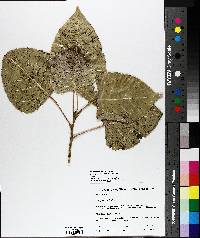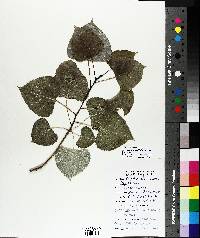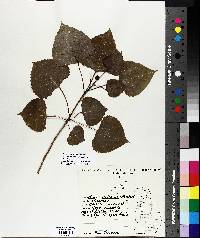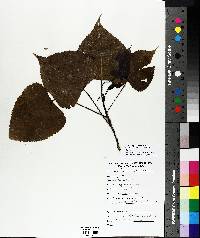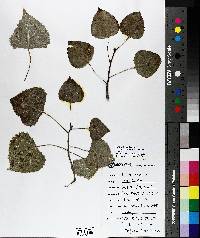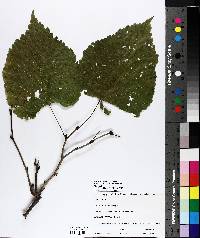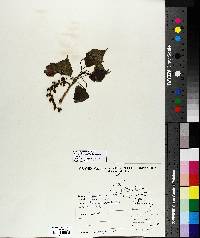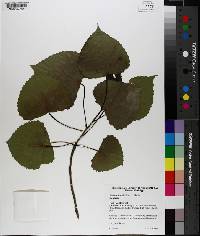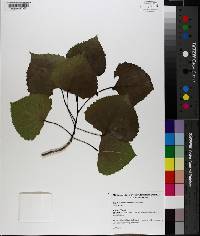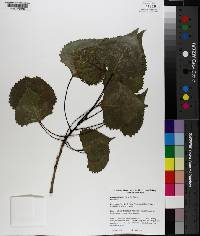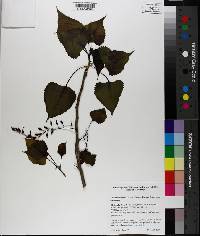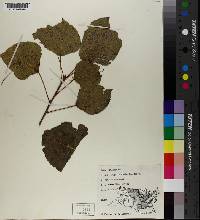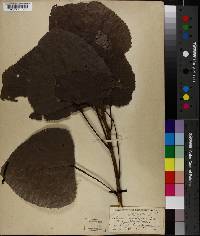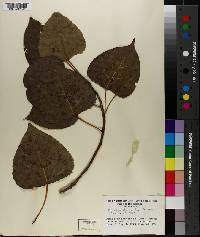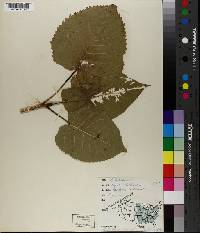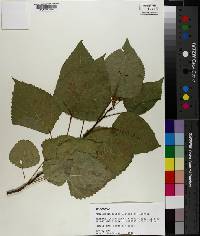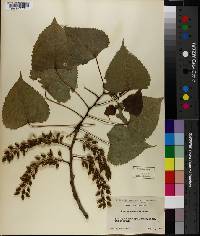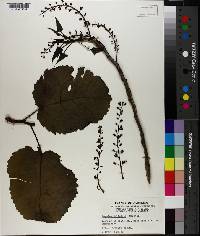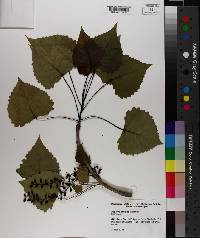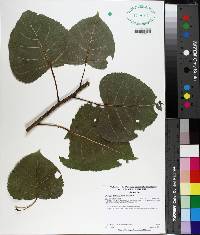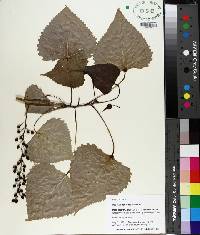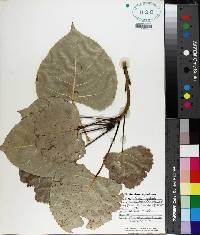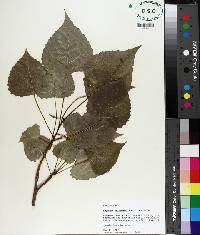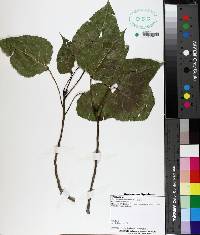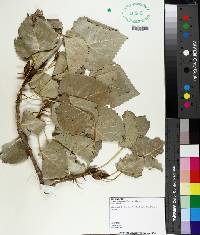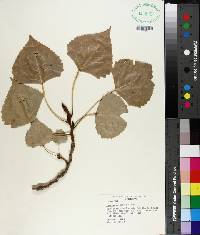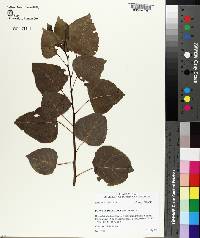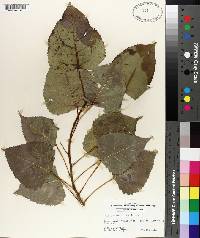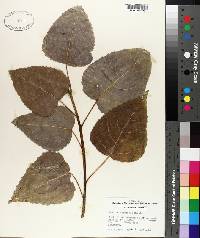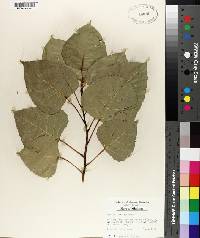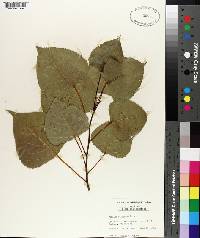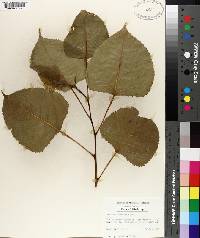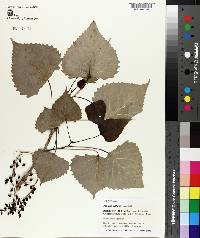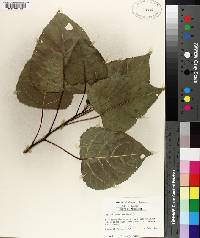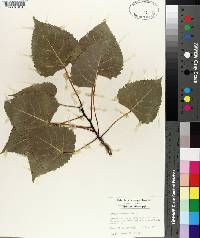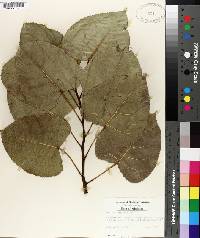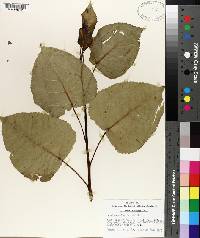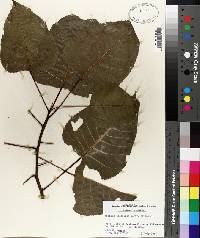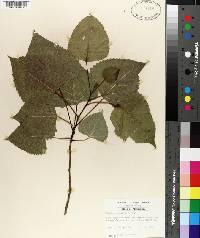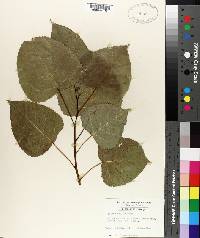
|
|
|
|
Family: Salicaceae
Eastern Cottonwood, more...common cottonwood, cottonwood, plains cottonwood
|
Plants to 55 m, 35 dm diam.; moderately to strongly hetero-phyllous, (often 2 or more trunks near base). Bark light brown, deeply furrowed. Branchlets yellow-brown, becoming tan by third year, round or 5-angled, coarse or not, (1-)2-3.5(-6) mm diam., glabrous or thinly long-hairy. Winter buds greenish yellow, glabrous or stiffly hairy, resinous (resin yellow, moderately fragrant); terminal buds (6-)8-15(-21) mm; flowering buds separated on branchlets, (8-)14-20(-28) mm. Leaves: petiole distally flattened at right angle to plane of blade, (1-)3-8(-13) cm, about equaling blade length, (glabrous); blade broadly triangular-ovate, (1-)3-9(-14) × (1.5-) 3-9(-16.5) cm, w/l = 4/5-6/5, base truncate to cordate or broadly cuneate, basilaminar glands 0-6, round or tubular, margins translucent, ciliate, apex abruptly short- or long-acuminate, surfaces grayish green to bright green, glabrous (or visibly pilose only at emergence); preformed blade margins coarsely crenate-serrate midblade, teeth (3-)5-15(-30) on each side (graded, rounded), sinuses (0.4-)0.7-5(-7) mm deep; neoformed blade margins crenate-serrate, teeth (10-) 25-40(-55) on each side (graded), sinuses (0.1-) 0.5-1.5(-3) mm deep. Catkins loosely (3-) 15-40(-55)-flowered, (0.7-)5-18(-24 in fruit) cm; floral bract apex deeply cut, not ciliate. Pedicels 1-13(-17 in fruit) mm. Flowers: discs saucer-shaped, not obviously oblique, entire, 1-3(-4) mm diam.; stamens 30-40(-55); anthers truncate; ovary (3- or)4-carpelled, ovoid; stigmas 2-4, platelike, spreading. Capsules ovoid, (4-)8-11 (-16) mm, glabrous, (3- or)4-valved. Seeds (3-)7-10 (-23) per placenta. 2n = 38. Plant: tree; to 55 m tall, not clonal; bark light brown, deeply furrowed. TWIGS yellow brown, turning tan by the third year, glabrous; winter buds resinous, greenish yellow, sparsely hirsute Leaves: usually ovate to triangular-ovate or circular, margins variously crenate-serrate; stipules minute, caducous INFLORESCENCE: CATKINS 5-13 cm long; bracts glabrous Flowers: with shallow disks, these 1-4 mm wide in fruit; stamens 50-80 Fruit: CAPSULES 8-15 mm long, narrowly ovoid, usually 4-valved REFERENCES: Eckenwalder, James E. 1992. Salicaceae. Ariz.-Nev. Acad. Sci. 26(1)2. Large tree 18 - 32 m tall, trunk diameter 0.5 - 1 m Leaves: alternate, on 5 - 10 cm long, flattened, yellowish leafstalks, green and shiny above, paler beneath, 6 - 12.5 cm long, nearly as wide, broadly triangular with a straight or slightly heart-shaped base and abruptly pointed tip, coarsely toothed with gland-tipped teeth (except tip and base), thick, and firm. In autumn the leaves turn yellow. Flowers: either male or female, borne on separate trees (dioecious) in hairy-bracted catkins. Male catkin short-stalked, reddish, 8 - 10 cm long, and densely flowered. Female catkin short-stalked, greenish yellow, 15 - 20 cm long, and few-flowered. Fruit: a two- to four-valved capsule, borne in 15 - 25 cm long drooping catkins, short-stalked, greenish brown, and elliptic. Seeds light brown with cottony hairs attached. Bark: thin, smooth, and gray on young trees, becoming thick, rough, and furrowed with age. Twigs: stout, yellowish green, gray, or tan, somewhat angled. Leaf scars large, triangular, with three large bundle scars each. Buds: yellowish brown, 1.25 cm long, slender, three-sided, long-pointed, and resinous. Terminal bud 1 - 2 cm long. Form: broadly rounded or irregular, spreading, and with some drooping branches. The trunk of open-grown trees often splits into two or more stems. Similar species: The similar Populus balsamifera and P. heterophylla differ by having rounded, not flattened leafstalks. Populus alba differs by having hairy leaves and leafstalks. For comparison, the similar leaves of P. nigra lack incurved teeth and are wider than long. Flowering: late March to early May, before the leaves Habitat and ecology: Common in a wide range of moist habitats, including bottomland woods, foredunes, and along streams. Seedlings can be found along ditches, around ponds, and in just about any moist depression. Very large specimens occur on wooded floodplains. Occurence in the Chicago region: native Notes: Illinois' largest tree was a Populus deltoides, located west of Gebhard Woods at the west end of Morris in Grundy County. It fell over in 1990. Though P. deltoides is sometimes planted as a shade tree, Populus species as a whole are subject to many diseases and insect pests, such as canker and tent caterpillars, which often kill the tree or make it unattractive. These risks, in conjunction with a water-hungry root system, have made Populus species less desirable for landscape use. The wood of P. deltoides is used for pulp, fuel, boxes, crates, plywood, furniture, excelsior, woodenware, and matches. Etymology: Populus is the Latin word for poplar. Deltoides means triangular. Author: The Morton Arboretum Tall tree with ±spreading branches and a broad crown, the bark becoming deeply furrowed and nearly black; terminal buds glabrous, viscid; petioles strongly flattened; lvs glabrous, typically broadly deltoid, 8-14 cm, nearly as wide, short-acuminate, broadly truncate or subcordate at base, serrate with incurved, callous-tipped teeth (the largest teeth mostly 2-5 mm deep), generally bearing 2-5 prominent glands on the upper side at the very base; lowest lateral veins of the lvs widely spreading; scales of the catkins fringed; floral disk 1.5-4 mm wide; stamens (30-)40-80; stigmas 3 or 4, broadly dilated; frs ovoid, 3-4- valved, 6-10 mm, on pedicels 3-10 mm, forming a loose raceme; seeds (3-)7-10(-18) per placenta; 2n=38. Low woods and moist prairies and river-banks; Que. and N. Engl. to Fla. and Tex., and w. to the base of the Rocky Mts. Var. deltoides, the eastern cottonwood, widespread in our range, has gray or reddish-brown twigs, glabrous winter-buds, and mostly 3-5 glands at the base of the lvs, the lvs of the short shoots with mostly 15-30 teeth per side. The wholly confluent var. occidentalis Rydb., the Great Plains cottonwood, forming gallery forests along the rivers across the plains, and encroaching into the westerly Great Lakes region, has yellowish twigs, finely pubescent winter buds, mostly only 2 basal glands on the lvs, and mostly only 5-15 teeth on each side of the often more deltoid-ovate and more long-acuminate lvs. (P. sargentii; P. deltoides ssp. monilifera) Gleason, Henry A. & Cronquist, Arthur J. 1991. Manual of vascular plants of northeastern United States and adjacent Canada. lxxv + 910 pp. ©The New York Botanical Garden. All rights reserved. Used by permission. From Flora of Indiana (1940) by Charles C. Deam This is one of the largest trees of the state and is found throughout. It grows only in low ground about ponds, in woodland, and along streams and ditches. …… Indiana Coefficient of Conservatism: C = 1 Wetland Indicator Status: FAC Deam (1932): The cottonwood is adapted to a moist soil, propagates easily, grows rapidly, and is one of the best trees for forestry purposes for planting overflow lands, and for planting where quick shade is desired, or for temporary windbreaks. Cottonwood has many uses, and was formerly an important timber tree, but the supply has so diminished that large trees have become quite scarce. The thick bark was much used by the boys of pioneers for whittling out toys. |
|
|
|

